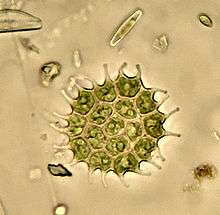Chlorophyceae
The Chlorophyceae are one of the classes of green algae, distinguished mainly on the basis of ultrastructural morphology. For example, the chlorophycean CW clade, and chlorophycean DO clade, are defined by the arrangement of their flagella. Members of the CW clade have flagella that are displaced in a "clockwise" (CW, 1–7 o'clock) direction e.g. Chlamydomonadales. Members of the DO clade have flagella that are "directly opposed" (DO, 12–6 o'clock) e.g. Sphaeropleales. They are usually green due to the dominance of pigments chlorophyll a and chlorophyll b. The chloroplast may be discoid, plate-like, reticulate, cup-shaped, spiral or ribbon shaped in different species. Most of the members have one or more storage bodies called pyrenoids located in the chloroplast. Pyrenoids contain protein besides starch. Some algae may store food in the form of oil droplets. Green algae usually have a rigid cell wall made up of an inner layer of cellulose and outer layer of pectose.
| Chlorophyceae | |
|---|---|
 | |
| Scientific classification | |
| Phylum: | Chlorophyta |
| Class: | Chlorophyceae Wille in Warming, 1884[1] |
| Orders[2] | |
General characteristics
- Plant body may be unicellular, colonial, filamentous, or multicellular.
- They are usually green due to the presence of chlorophyll a, chlorophyll b and beta-carotene.
- The chloroplast may be discoid, cup-shaped (e.g. Chlamydomonas), spiral or ribbon shaped (e.g. Spirogyra)
- Most chlorophytes have one or more storage bodies called pyrenoids (central proteinaceous body covered with a starch sheath) that are localised around the chloroplast.
- The inner cell wall is made of cellulose and the outer layer is pectose.
- Asexual reproduction is by zoospores. They are flagellates produced from the parent cells by mitosis. Also by aplanospores, hepnospores, akinetes, Palmella stage, etc.
- Sexual reproduction of plants is isogamous, anisogamous or oogamous.
Reproduction
Vegetative reproduction usually takes place by fragmentation. Asexual reproduction is by flagellated zoospores. And haplospore, perrination (akinate and palmellastage). Asexual reproduction by mytospore absent in spyrogyra. Sexual reproduction shows considerable variation in the type and formation of sex cells and it may be isogamous e.g. Chlamydomonas, Ulothrix, Spirogyra, anisogamous e.g. Chlamydomonas, Eudorina or Oogamous e.g. Chlamydomonas, Volvox. Chlamydomonas has all three types of sexual reproduction.
They share many similarities with the higher plants, including the presence of asymmetrical flagellated cells, the breakdown of the nuclear envelope at mitosis, and the presence of phytochromes, flavonoids, and the chemical precursors to the cuticle.[3]
The sole method of reproduction is asexual and azosporic. The content of the cell divide into 2,4 (B), 8(C) sometimes daughter protoplasts. Each daughter protoplast rounds off to form a non-motile spore. These autospores (spores having the same distinctive shape as the parent cell) are liberated by the rupture of the parent cell wall (D). On release each autospore grows to become a new individual. the presence of sulphur in the culture medium is considered essential for cell division. it takes place even in the dark with sulphur alone as the source material but under light conditions nitrogen also required in addition. Pearsal and Loose (1937) reported the occurrence of motile cells in Chlorella. Bendix (1964) also observed that Chlorella produces motile cells which might be gametes. These observations have an important bearing on the concept of the life cycle of Chlorella, which at present is considered to be strictly asexual in character.
Asexual reproduction in Chlorella ellipsoides has been studied in detail and the following four phases have been observed during the asexual reproduction.
(i) Growth Phase- During this phase the cells grow in size by utilizing the photosynthetic products.
(ii) Ripening phase- In this phase the cells mature and prepare themselves for division.
(iii) Post ripening phase- During this phase, each mature cell divides twice either in dark or in light. The cells formed in dark are known as dark to light phase, cells again grow in size.
(iv) Division Phase- During this phase the parent cell wall ruptures and unicells are released.
Classification
The following orders are typically recognised:
- Dunaliellales (e.g. Dunaliella)
- Chlamydomonadales (e.g. Volvox, Chlamydomonas)
- Chlorococcales
- Oedogoniales (e.g. Oedogonium)
- Sphaeropleales
- Chaetophorales
- Microsporales
- Tetrasporales (e.g. Tetraspora)
In older classifications, the term Chlorophyceae is sometimes used to apply to all the green algae except the Charales, and the internal division is considerably different.
The Orders of the Chlorophyceae as listed by: in Hoek, Mann and Jahns (1995)[4]
- Volvocales
- Chlorococcales
- Chaetophorales
- Oedogoniales
See also
References
- Warming, E., 1884. Haandbog i den systematiske botanik. Anden gjennemsete udgave. 2nd ed. Kjøbenhavn, 434 pp. German translation (1890) of the 2nd Danish edition available at archive.org: . English translation (1895) of the 3rd Danish edition (1892) available at archive.org: .
- Guiry, M.D.; Guiry, G.M. (2007). "Class: Chlorophyceae taxonomy browser". AlgaeBase version 4.2 World-wide electronic publication, National University of Ireland, Galway. Retrieved 2007-09-23.
- Raven, Evert and Eichhorn. The Biology of Plants 7th edition, pg. 335. W. H. Freeman and Company, New York, 2005.
- Hoek, C.van den, Mann, D.G. and Jahns, H.M. 1995. Algae An Introduction to Phycology. Cambridge University Press, Cambridge